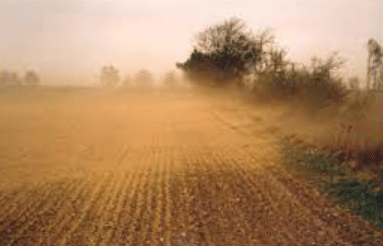Soil Erosion and Conservation Class 5 Notes Science
| Table of contents |

|
| Introduction |

|
| What is Soil? |

|
| Soil Formation |

|
| What is Soil Erosion? |

|
| Soil Conservation |

|
Introduction
- Did you know that the ground you walk on has been forming for thousands of years?
- It starts with rocks breaking down into small pieces, which gradually become the soil we see today.
- Soil is not just the top layer of dirt; it has hidden layers underneath, each serving a unique purpose.
- Under this topic, we will first look at how soil is made and examine its different layers, known as the soil profile.
- But soil faces a big problem called erosion, where wind and water can carry it away.
- Don't worry—there are smart ways to save soil and protect it from being lost.
- Let’s explore why healthy soil is so essential!

What is Soil?
- Soil is the topmost layer of the Earth.
- It is essential for plant growth, as it supports life on Earth.
- Soil is home to many animals like earthworms, ants, moles, snakes, and rabbits.
Soil Formation
- Big rocks are broken down by the action of sun, wind, and water into smaller pieces till a powder is formed. This process is called weathering.
- The fine powder mixes with the remains of dead plants and animals to form soil.

- It takes millions of years for rocks to change into soil.
- Soil is made up of gravel, sand, clay particles, and humus.
- Humus is the remains of dead plants and animals found in the soil.
- Soil also contains air, water, and microorganisms like bacteria and fungi.
Soil Profile
Soil profile is the layers of soil. It has three layers — topsoil, subsoil and bedrock. Let's learn about them all.

1. Topsoil
- The topmost layer of soil is called topsoil.
- It is made up of sand, clay, humus, air, and water.
- Humus is important because it gives essential nutrients to plants, helping them to grow.
2. Subsoil
- The middle layer is known as subsoil.
- This layer has small bits of broken rocks and water.
- It contains very little humus.
3. Bedrock
- The bottom layer is referred to as bedrock.
- This layer is deep within the Earth and consists of large pieces of rock.
- There is not much water found in this layer.
What is Soil Erosion?
Topsoil is the most fertile layer, as it contains humus. Strong winds and water, and human activity can carry topsoil to new places. This process of wearing off or carrying away of the topsoil by the action of wind or water is called soil erosion.
- Water Causes Erosion: When it rains, some rainwater soaks into the ground and some evaporates. The rest of the rainwater flows over the land. As it flows, it takes soil along with it and thus causes soil erosion. The faster the flow of water, the more soil erosion it causes.

- Wind Causes Erosion: Some places such as deserts or semi-deserts have very few plants covering the ground. Here wind can blow away the dry top soil. The harder the wind blows, the more soil it carries.

- Humans Activities Increase Erosion: Humans have cleared large areas of forests for their requirement of wood, living space and farmland. This deforestation has left the land bare and increased soil erosion. Soil that has developed over thousands of years can disappear in months because of deforestation.

- Overgrazing by Cattle: This also removes plants from the soil, leaving it bare, resulting in soil erosion.

Soil Conservation
- Soil needs to be protected because our lives are dependent on it.
- Nature can take over 100 years to replace 1 cm layer of soil lost by erosion.
- It is therefore important to take steps to reduce erosion.
- Protecting soil from erosion is called soil conservation.
Methods of conserving the Soil
- Afforestation: Trees and plants bind the soil with their roots. They offer the best protection against soil erosion. Planting trees or afforestation, especially in hilly areas is a very effective method of soil conservation.
- Step Farming in Hilly Areas: To reduce soil erosion, farming in hilly areas is done by cutting steps in the slopes, which is also known as terrace farming. This reduces the speed with which the water flows down. Also, some of the soil eroded from one step gets deposited on the next step.

- Keeping Bare Soil Covered After Harvesting: On flat ground or plains, soil erosion occurs in farmlands after a crop is harvested. The soil then lies bare and can be easily eroded by water and wind.
- Building Embankments Along Riverbanks: Strong embankments are made along the banks of rivers to reduce erosion. This prevents soil erosion in two ways.
Firstly the constant erosion of the soil from the river banks is prevented.
Secondly, the embankments prevent the flooding of land by the rivers.

|
42 videos|230 docs|45 tests
|
FAQs on Soil Erosion and Conservation Class 5 Notes Science
| 1. What is the definition of soil? |  |
| 2. How is soil formed? |  |
| 3. What causes soil erosion? |  |
| 4. What are some methods of soil conservation? |  |
| 5. Why is soil conservation important? |  |





















